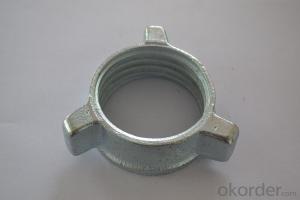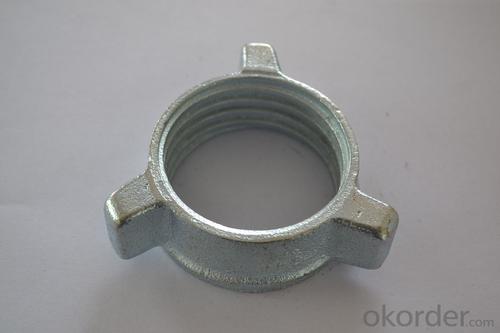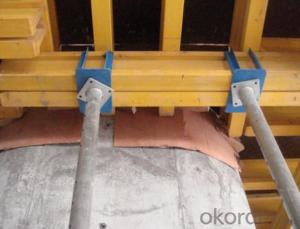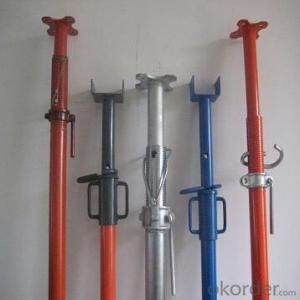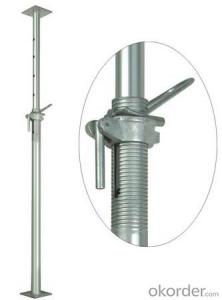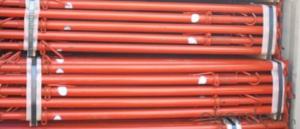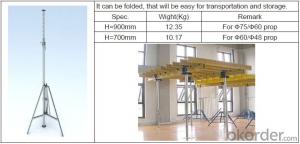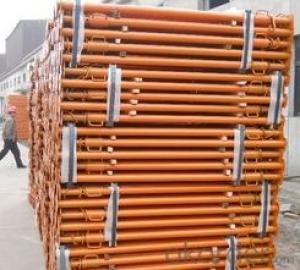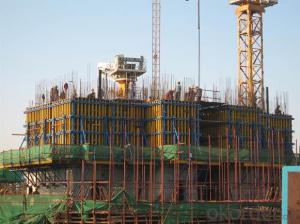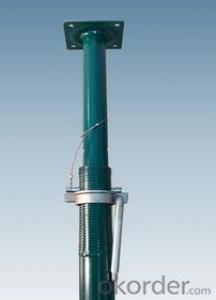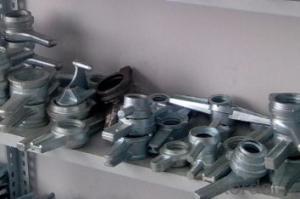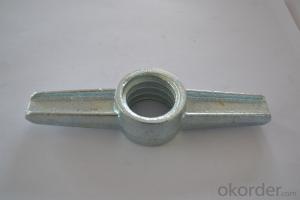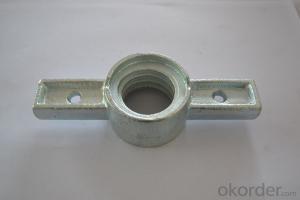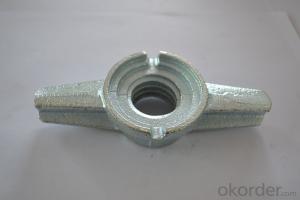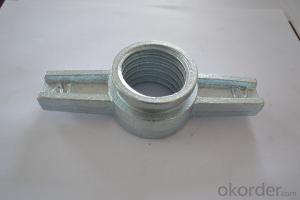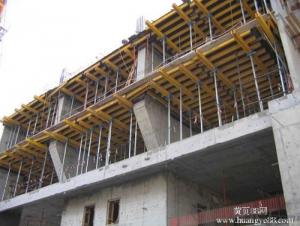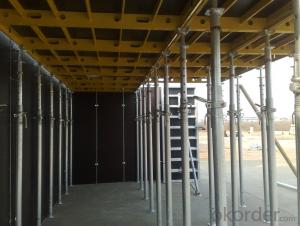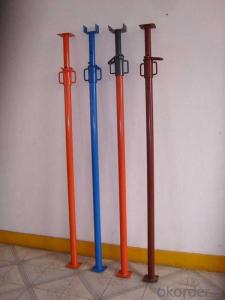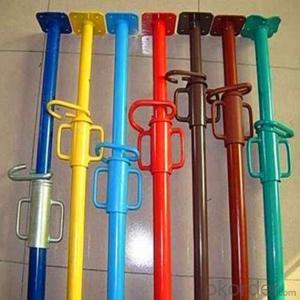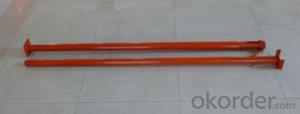OEM Two wing Butterfly Wing Nuts 11
- Loading Port:
- China Main Port
- Payment Terms:
- TT OR LC
- Min Order Qty:
- -
- Supply Capability:
- -
OKorder Service Pledge
OKorder Financial Service
You Might Also Like
Quick Details
| Model Number: | |||||
| Standard: | Type: | Certification: | |||
| Material: | Surface: |
Packaging & Delivery
| Packaging Detail: | Plastic bag, pallet packing, carton box, by customer's requirement |
| Delivery Detail: | within 30days after payment |
Specifications
Two wing Butterfly Wing Nuts
1>Excellent dimension accuracy
2>Finished: per your requirements
3>factory directly supply
Two wing Butterfly Wing Nuts
We supply kinds of metal parts totally according to clients' drawings and samples and special requirement.
1. Material: Ductile iron .
2. Sizes: Inner hole Dia 15/17mm.
We have different sizes ,types of wing nut to meet your needs, save your cost .
3. Weight: 0.35kg,thread pitch: 10.0mm.(or 6.35mm)
4. Surface: White Zinic , Yellow Zinic or painted, self color
5 Thread:casted or machine tap.
1. 12000M2 standard modern workshop guarantee production capability to satisfy the customers needs
2. Our Independent quality control department,Which make sure the quality of all products
3. Our efficient and experienced sales team ,provide friendly and thoughtful service for clients from all over the world
- Q: Can steel props be used in the installation of temporary fencing or barriers for crowd control?
- Yes, steel props can be used in the installation of temporary fencing or barriers for crowd control. Steel props provide stability and strength, making them suitable for supporting temporary fencing systems and ensuring effective crowd management and control.
- Q: What are the common safety certifications or standards for steel props?
- Some common safety certifications or standards for steel props include the European Standard EN 1065, the British Standard BS 4074, and the Australian/New Zealand Standard AS/NZS 3610. These standards ensure that steel props are designed, manufactured, and tested to meet specific safety requirements, providing assurance of their strength, stability, and load-bearing capacity.
- Q: Can steel props be used to support beams and columns?
- Steel props, referred to as scaffolding props or shoring props, are capable of supporting beams and columns. These props, which are temporary structural devices, are frequently utilized in construction to bear loads while buildings, bridges, or other structures are being constructed or renovated. They can be adjusted in height and installed or removed with ease. Constructed from high-strength steel, steel props possess the necessary load-bearing capacity to safely support beams and columns. They are widely used to offer temporary support during the construction of concrete beams and columns, thereby ensuring stability and averting any structural failure. Steel props are a flexible and dependable solution for supplying temporary support to beams and columns throughout construction projects.
- Q: How do steel props compare to steel columns?
- Steel props and steel columns are both structural elements commonly used in construction projects, but they serve different purposes and have different characteristics. Steel props, also known as adjustable steel props or adjustable steel props, are temporary supports used to provide vertical support during construction or renovation activities. They are typically used to support formwork, beams, slabs, or other structural elements. Steel props are adjustable in height, allowing them to be used in various applications and to accommodate different load requirements. They are easily adjustable and can be quickly installed or removed, making them highly versatile and cost-effective. On the other hand, steel columns are permanent structural elements that support the weight of the structure above. They are designed to withstand vertical loads and transfer them to the foundation, providing structural stability and integrity to the overall building or structure. Steel columns are typically designed based on engineering calculations and architectural requirements, considering factors such as the height of the building, the loads it will bear, and the overall structural design. In terms of comparison, steel props and steel columns serve different purposes and cater to different construction needs. Steel props are temporary supports that provide vertical support during construction activities, while steel columns are permanent structural elements that provide long-term stability to the structure. Both elements are made of steel and offer strength and durability. However, steel columns are typically designed to withstand higher loads and provide greater structural integrity compared to steel props. Additionally, steel columns are part of the overall structural system and require careful engineering and design considerations. On the other hand, steel props are more flexible and can be adjusted to accommodate different load requirements, making them suitable for various construction applications. In summary, steel props and steel columns are both important structural elements in construction projects, but their purposes and characteristics differ. Steel props are temporary supports used during construction activities, while steel columns are permanent structural elements that provide long-term stability to the structure. Both elements offer strength and durability, but steel columns are typically designed to withstand higher loads and provide greater structural integrity compared to steel props.
- Q: How do you secure a steel prop in place?
- To secure a steel prop in place, there are a few steps you can follow: 1. Choose the right size and type of steel prop: Ensure that the prop you select is the appropriate size and type for the task at hand. The prop should be able to support the weight and load it will be subjected to. 2. Positioning: Place the steel prop in the desired location, ensuring it is aligned properly and in the correct orientation. Make sure it is positioned on a stable and level surface that can bear the weight. 3. Adjust the height: Extend or retract the prop to the desired height. Most steel props have an adjustable screw mechanism that allows you to adjust the height according to your requirements. 4. Tighten the prop: Once the prop is at the correct height, secure it in place by tightening the locking mechanism. This could involve turning a handle, tightening a nut, or using a locking pin, depending on the specific design of the steel prop you are using. 5. Check stability: After securing the prop, check its stability to ensure it is firmly in place. Give it a gentle shake or push to see if it remains steady. If it wavers or seems unstable, reposition or adjust it until it is secure. 6. Test load-bearing capacity: If your task involves placing a load on the steel prop, it is important to test its load-bearing capacity. Gradually add the load while monitoring the prop's stability. Avoid exceeding the recommended maximum load capacity to prevent any accidents. 7. Regular inspections: Periodically inspect the steel prop to ensure it remains secure and in good condition. Look for any signs of wear, damage, or loosening of the locking mechanism. If any issues are detected, address them promptly to maintain the prop's stability and safety. Following these steps will help you effectively secure a steel prop in place, ensuring stability and safety for your construction or support needs.
- Q: What are the common sizes of steel props available in the market?
- The common sizes of steel props available in the market typically range from 1.8 meters to 5 meters in length, with adjustable heights ranging from 1.8 meters to 3.5 meters.
- Q: Why should the deep foundation pit support axial force monitoring? Or what is the monitoring of the supporting axial force in order to know the state of the foundation pit? Like this, a few words summed upColumn settlement monitoringPost settlement monitoring, foundation pit excavation and precipitation affected during the construction process, the pile may produce uneven settlement, post too much uneven settlement will cause the entire support system instability, therefore need to monitor post settlement.I was in order to do the monitoring program, the trouble to know back, thank you!!!
- Generally, the supporting structure of continuous wall (pile) and steel support is used. We are using the axial force meter (anti force meter) test, relatively stable his surname is good, can instantly reflect the conditions. They also used the steel stress meter, surface gage, the effect is not how good, especially the strain gauge could not reflect the working condition, and easily broken (numerical measure out), do not know is not associated with the installation process?
- Q: Can steel props be used in the installation of temporary security or surveillance systems?
- Yes, steel props can be used in the installation of temporary security or surveillance systems. Steel props, also known as steel support beams or steel shoring, are commonly used in construction to support temporary structures or provide additional stability. They are designed to bear heavy loads and ensure structural integrity. When it comes to installing temporary security or surveillance systems, steel props can be utilized to provide a stable base for mounting cameras, sensors, or other equipment. These props can be adjusted to different heights and securely fixed in place, allowing for flexibility in positioning the surveillance systems. Moreover, steel props are durable and resistant to various weather conditions, making them suitable for outdoor applications. They can withstand wind, rain, and other environmental factors, ensuring the stability and functionality of the installed security or surveillance systems. However, it is important to consider the specific requirements and specifications of the security or surveillance systems being installed. Steel props should be selected based on their load-bearing capacity, adjustability, and compatibility with the equipment being used. Additionally, the installation should comply with relevant safety regulations and guidelines to ensure the proper functioning and effectiveness of the security or surveillance systems.
- Q: What are the advantages of using steel props over other support systems?
- There are several advantages of using steel props over other support systems. Firstly, steel props are highly durable and have a high load-bearing capacity, making them suitable for supporting heavy loads. Secondly, steel props are adjustable, allowing for easy customization and flexibility in construction projects. Additionally, steel props are lightweight and easy to handle, making them convenient to transport and install. Lastly, steel props provide enhanced safety as they are designed to withstand various environmental conditions and are less prone to damage or collapse.
- Q: Are steel props adjustable with a single person?
- Yes, steel props can be adjusted by a single person. They are designed with an adjustable mechanism that allows one person to easily change the height to fit various requirements.
Send your message to us
OEM Two wing Butterfly Wing Nuts 11
- Loading Port:
- China Main Port
- Payment Terms:
- TT OR LC
- Min Order Qty:
- -
- Supply Capability:
- -
OKorder Service Pledge
OKorder Financial Service
Similar products
Hot products
Hot Searches
Related keywords
